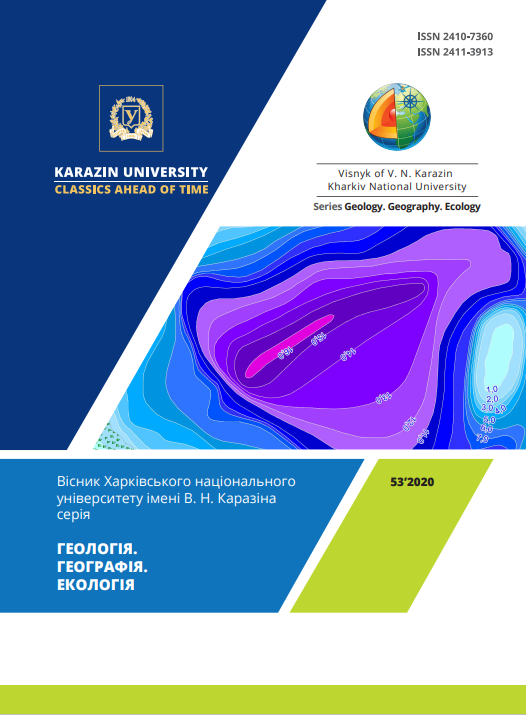Application of the surface layer energy balance model for calculating of the evaporation from water objects
Abstract
Formulation of the problem. When solving hydrological problems associated with the water balance of water bodies and the possibility of economic use of their water resources, an important problem is the accurate determination of evaporation from the water surface, which is the main component of water losses.
Review of previous publications and studies.Currently, many indirect and empirical methods for calculating evaporation from the surface of soil, water and vegetation, developed by domestic and foreign scientists: M.I. Budyko, V.S. Mezentsev, A.R. Konstantinov, N.N. Ivanov, Penman-Monteith and others, are used. Most empirical methods do not have universal applicability, since, in most cases, they cannot take into account the features of various underlying surfaces and hydrometeorological conditions that affect evaporation processes.
The only acceptable methods for estimating actual or potential evaporation can only be parametric models based on a numerical solution of the surface heat balance equation. One of such models is the atmospheric surface layer model – model SLEB, created at Odessa State Ecological Environmental University.
Purpose. The purpose of this study is to obtain quantitative estimates of changes with evaporation of water surfaces with SLEB model and compare them with the measured and model data of analogous methods obtained by other authors (Ivanova, Penman), for example, a freshwater lake Yalpug.
Methods. For research, a parametric energy balance model of the atmospheric surface layer SLEB, which is used standard meteorological information, was used. The main advantage of this model is the high accuracy of determining the heat expenditure for evaporation in the calculation of mass-heat transfer between the underlying surface and the atmosphere at the micro- and mesoscales. The SLEB model is applicable for all types of underlying surfaces characteristic of the territory of Ukraine.
Results. The value of evaporation from unit area of the water surface of Lake Yalpug calculating by model SLEB was obtained for the first time taking into account the development of wave formation on the surface of the lake, which changes the hydrodynamic properties of the water surface and the aerodynamics of the air flow.
Accounting for the effect of wind waves on the vast lake surface allowed us to obtain results almost equal to the measured evaporation from the pool surface.
The results showed that the calculated values of evaporation from the water surface by the methods of Penman and Ivanov overestimate the amount of evaporated moisture compared with the values measured and calculated by the SLEB model.
Conclusions. Application of the SLEB model allows to increase the quantitative estimation accuracy of the water balance main component – water losses due to evaporation from the water bodies water surface, which, in turn, can increase the water resources management efficiency of natural water bodies for purpose of their rational use for drinking water supply and land irrigation.
Downloads
References
Budyko M.I. (1956). Heat surface balance, 256.
Mezentsev V.S. (1962).To the method of calculating the the total evaporation and soil moisture characteristics for an intra-annual period. Proceedings of the Omsk Agricultural Institute, XXVII, 35-54.
Ivanov N.N. (1954). Obout of the determination of the evaporation values. Proceedings of the Russian Geographical Society, 86 (2).
Beven Keith. (1979). A sensitivity analysis of the Penman-Monteith actual evapotranspiration estimates. Journal of Hydrology, 44 (3-4), 169-190. https://doi.org/10.1016/0022-1694(79)90130-6.
Monteith J.L., Penman H.L. (1965). Evaporation and environment. Symposia of the Society for Experimental Biology, 19, 205-224.
Budagovskij А.I. (1969). Evaporation of soil moisture. Moscow: Nauka, 241.
Konstantinov А.R. (1968). Evaporation in nature. Leningrad: Gidrometeoizdat, 582.
Pushistov P.Yu., Shlychkov V.A. (1992). Conclusion of balance relations for the mesoscale climate model of heat and moisture exchange in the atmosphere - hydrosphere - vegetation - soil system. Proceedings of SibNIGMI, 100, 129-146.
Postnikov А.N. (2009). Methods for calculating soil evaporation in various natural zones. Scientific notes of the Russian State Hydrometeorological University, 10, 21-31.
Priestly C.H.B. and Taylor R.J. (1972). On the Assessment of Surface Heat Flux and Evaporation Using Large-scale Parameters. Monthly Weather Bev, 1, 81-92. https://doi.org/10.1175/1520-0493(1972)100<0081:OTAOSH>2.3.CO;2.
Brutsaert W. (1982). Evaporation in to the Atmosphere (Theory, History and Applications). D. Reidel Publishing Co., Dordrech, Boston, London, 299.
XU C.-Y and V.P. SINGH. (2002). Cross Comparison of Empirical Equations for Calculating Potential Evapotranspiration with Data from Switzerland. Water Resources Management, 16, 197-219.
Jensen M.E. and Haise H.R. (1963). Estimation of Evapotranspiration from Solar Radiation. Journal of Irrigation and Drainage Division, Proc. Amer. Soc. Civil Eng, 89, 1541.
Hargreaves G.H. and Samni Z.A. (1982). Estimation of Potential Evapotranspiration. Journal of Irrigation and Drainage Division, Proceedings of the American Society of Civil Engineers, 108, 223-230.
Berry J.A., Baker I., T. Randall, D.A. Sellers. (2012). Soils, plant growth and crop production. P. J. The Soil-Plant-Atmosphere System. Past and Present – Vol. 1. (Soil-Plant-Atmosphere Dynamics).
Chen F., Pielke R., Sr. K. Mitchell. (2001). Development and application of land-surface models for mesoscale atmospheric models. American Geophysical Union, 107-135.
Xiu A., Pleim J.E. (2001). Development of a land surface model. Part I: Application in a mesoscale meteorological model. J. Appl. Meteorol, 40 (2), 192-209. https://doi.org/10.1175/1520-0450(2001)040<0192:DOALSM>2.0.CO;2.
Voloshin V.G. (2013). Dynamic model of atmospheric pollution with a meteorological preprocessor. Оdessа: TES, 285.
Stepanenko S.N., Voloshin V.G., Kuryshina V.Yu. (2011). The surface layer energy balance model. Ukrainian hydrometeorological journal, 9, 38-59.
Rauner Yu.L. (1972). Heat balance of vegetation. Leningrad: Gidrometeoizdat, 210.
Voloshin V.G. (2002). Method for calculating turbulent flows and surface temperature based on meteorological observations. Meteorology, climatology and hydrology, 46, 83-89.
Voloshin V.G., Kuryshina V.Yu. (2016). Dissipation functions of turbulent energy in the atmospheric surface layer. Ukrainian hydrometeorological journal, 15, 2-8. https://doi.org/10.31481/uhmj.16.2015.09.
Stepanenko S.N., Voloshin V.G., Kuryshina V.Yu., Golovatyuk N.D. (2012). Method for calculating the surface temperature by standard meteorological observations. Ukrainian hydrometeorological journal, 11, 18-29.
Gippius F.N., Arkhipkin V.S., Frolov A.V. (2016). Seasonal course evaporation from Caspian surface taking into account the influence of waves and sea depth. Moscow University Bulletin. Series 5. geography, 5, 86-91.





